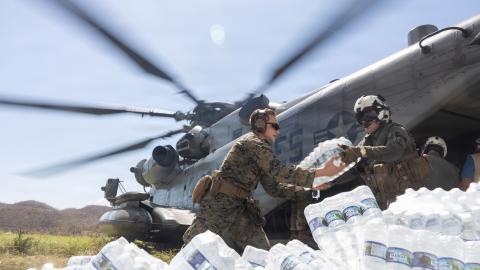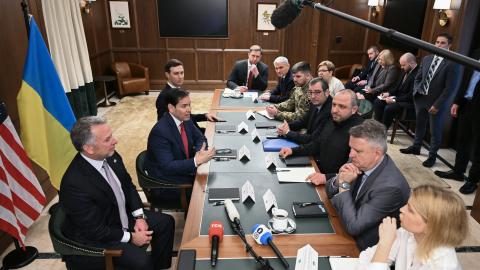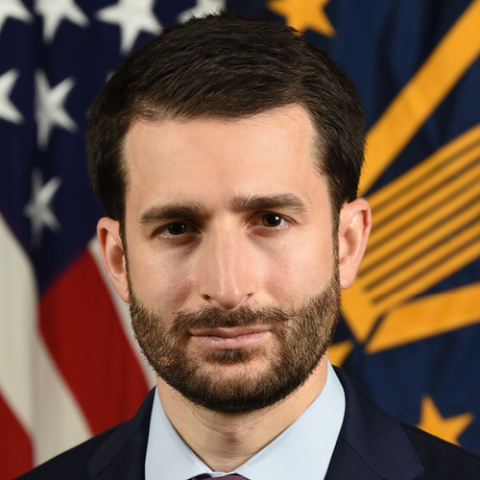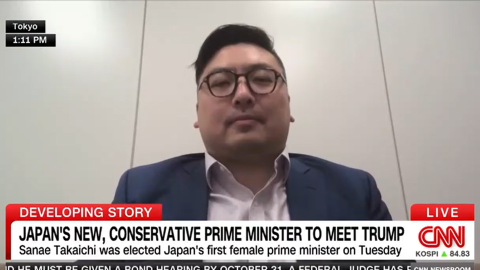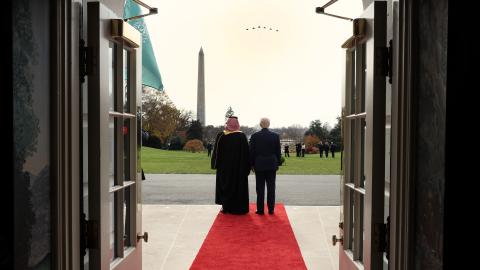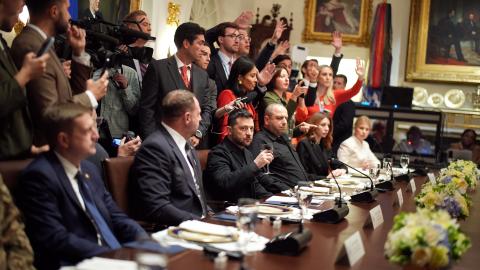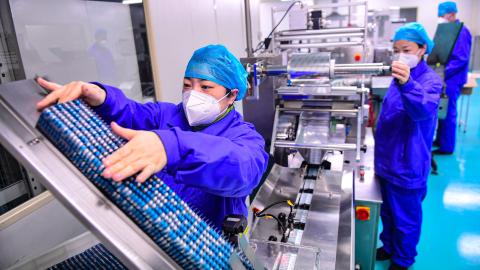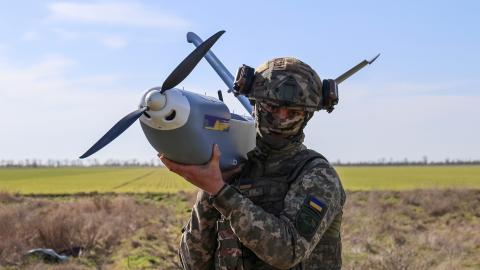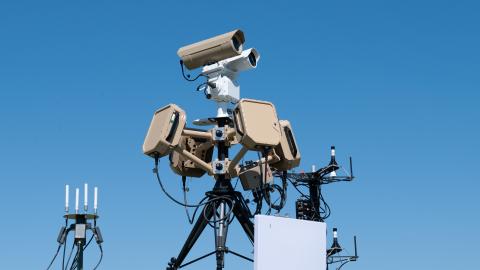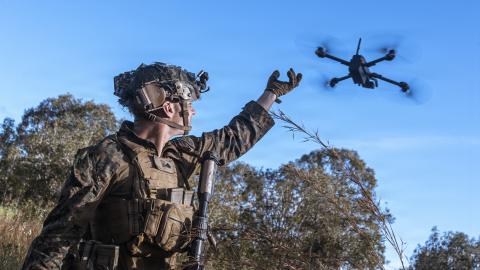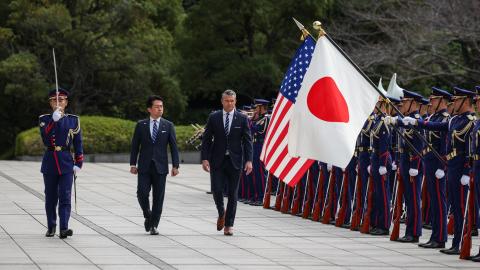
AUKUS Pillar 2: New Partners and Opportunities
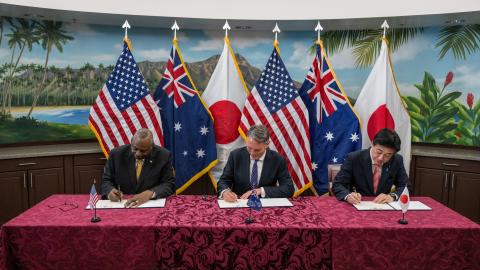

Chief Strategy Officer, Anduril Industries
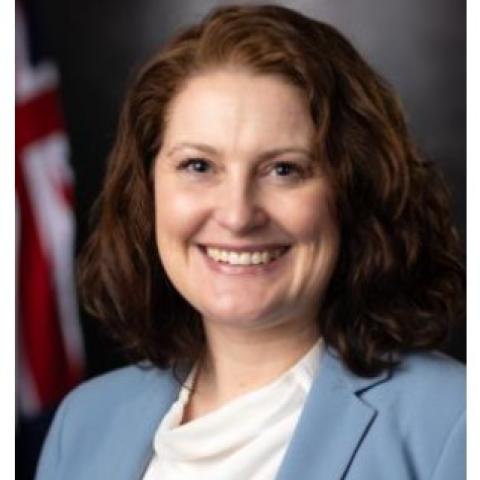
Minister-Counsellor for AUKUS, Australian Embassy

Fellow, Center for Defense Concepts and Technology
David Byrd is a fellow with Hudson Institute's Center for Defense Concepts and Technology.
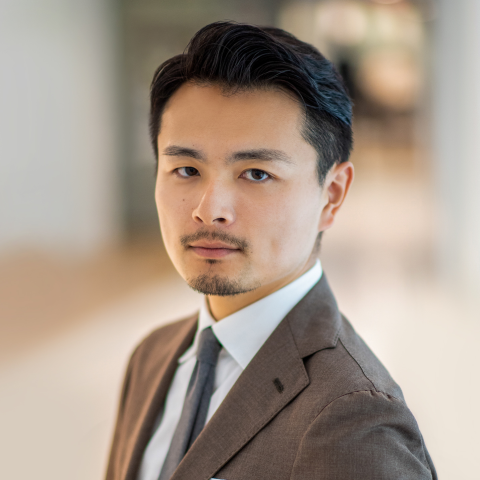
Senior Fellow, Japan Chair
Masashi Murano is a senior fellow with Hudson Institute’s Japan Chair.

Japan Chair
Kenneth R. Weinstein is the Japan Chair at Hudson Institute.
In April 2024, the governments of the AUKUS (Australia–United Kingdom–United States) security partnership announced their willingness to cooperate with Japan on advanced capabilities projects as part of AUKUS Pillar 2. To date, the group has set up eight such working groups in areas including artificial intelligence, information sharing, and hypersonic missile technology. Given Japan’s technological capabilities and close cooperation with each of the AUKUS partners, Tokyo would bring considerable value to AUKUS Pillar 2.
Hudson Japan Chair Kenneth R. Weinstein will host a panel with Chris Brose of Anduril, Phoebe Greentree of the Australian Embassy, and Hudson’s David Byrd and Masashi Murano to discuss the challenges and opportunities for Japan’s potential participation in AUKUS Pillar 2, how the program may need to evolve, and the wider security and technological implications of Japanese involvement in the program.
Event Transcript
This transcription is automatically generated and edited lightly for accuracy. Please excuse any errors.
Kenneth R. Weinstein:
Well, good morning. I’m Ken Weinstein, Japan Chair and President Emeritus here at Hudson Institute. I am delighted to welcome everyone to our event today on AUKUS PILLAR II in Japan. It’s rare to get this much of a crowd on a relatively early morning for Washington, late August, and so it just shows the interest in the subject here, and I want thank first and foremost Dr. Will Chu, Deputy Director of the Japan Chair here at Hudson Institute for all the help in pulling this event together as we approach September 15th, which is the third anniversary of the Australia US or Australia-UK-US Trilateral Security Partnership, it’s clear that the centrality of technology and innovation to security has taken hold in the Indo-Pacific.
AUKUS of course consists of two separate baskets, the development and construction of nuclear-powered submarines for the Australian Navy as well as the development and deployment of cutting-edge technologies such as Quantum AI, hypersonics, as well as command and control and battlefield management structures critical to maritime domain awareness and securing sea lanes for free and open Indo-Pacific. Japan, which is not in AUKUS shares a similar strategic outlook on the challenges of Indo-Pacific security as well as on the centrality of technology, as do the AUKUS strategic partners.
This April during Prime Minister Kishida’s historic visit here to Washington deliberations over Japan’s potential participation in PILLAR II of AUKUS moved into high gear. Japan offers the potential for significant contributions through the second pillar as an industrial and technological force in its own right, but there are significant details involving procedure, organization, information security protocols and beyond before Japan can be formally invited to join PILLAR II. What would Japan’s participation in PILLAR II mean for AUKUS? What would it mean for Japan and what are the implications more broadly for Indo-Pacific security? We have a very distinguished panel with us this morning and we’ll hear shortly from David Byrd of Hudson Institute Center for Defense Technology and concepts. Chris Brose of Anduril Industries, the minister counselor for AUKUS at the Australian Embassy to the US Phoebe Greentree and Masashi Murano Japan Chair, senior fellow here at Hudson Institute.
So let’s kick it off first with David Byrd who’s going to give us an overview of AUKUS and Japan’s participation in AUKUS. David is a fellow with Hudson Institute Center for Defense Concepts and Technology. He is an expert in future concept development, data analytics and the application of AI to military problems, and his research focuses on the evolution of space as a war fighting domain and the implications of new technologies on forced design and war fighting concepts. So turn it over to David and then I will introduce each of our speakers in turn and we’ll go in this direction.
David Byrd:
Thanks, Ken. Yeah, faith is a war fighting domain. That one I don’t know yet.
Kenneth R. Weinstein:
Losing face is key in the Indo-Pacific.
David Byrd:
So before I talk a little bit about AUKUS, I’m going to start by just framing what are the operational problems in the Indo-Pacific because that’s really what’s driving this partnership and driving these investments, and really there’s four main four thrusts that really drive this activity. First is the simple force imbalance of the US and China and the Indo-Pacific. Right now, China’s on a tear of a military buildup program, especially shipbuilding. By 2025, the PLAN is expected to be larger than the entire US Navy, and this is even more drastic in the Indo-Pacific because while the US has to operate all around the globe, the PLAN is largely focused in its own backyard, and this force imbalance extends not only to shipbuilding but also submarines, aircraft, long-range missiles, basically any kind of competition of fires. China’s goal has been to surpass the US in both mass and at the very least, match it in technological sophistication.
That’s the first problem. Second problem is a range in geography. So over the past two decades, maybe even longer, the PLAN has invested heavily in anti-axis and anti-area denial weapons, and this is two effects. One, it’s pushed high-value US assets further and further east in order to keep them safe. So this means we have harder logistics. It takes longer time to respond to any sort of crisis, and all of our operational planning becomes more constrained due to the tyranny of time and space. Second impact of that is that anything we do choose to put inside the threat bubble is now at extremely high risk. It makes it very difficult to amass any kind of force that could respond in time or could respond proactively to any sort of conflict or crisis. Third, it’s not just a warfare problem. The PRC considers competition with the US and its allies along an entire spectrum of operations.
You may have heard the term gray zone. So China doesn’t make a very sharp difference between activities in wartime and activities in peacetime. They’re all part of a continuum and they’re only managed by their intensity. However, the types of assets and the types of activities you’re doing to combat gray zone operations, which might be things like illegal fishing, harassing of trade routes, violations of national sovereignty, these require presence and they require a very rapid response in order to effectively contest. Meanwhile, we have an entire force that’s built around high survivability assets that are few in number and we are loathe to risk. So we have orthogonal demands between what we want to do in wartime and what we want to do in peacetime, and then the final operational problem is that we have to consider the needs of our regional allies because it’s not just the US versus China.
The China’s neighbors are facing an even greater force imbalance than the US obviously, and many of them don’t have the luxury of moving east to further stand-off to keep their assets safe. All of Japan exists within China’s missile threat range. So their considerations for what kind of force they need and how to protect it are very different from ours, and that’s something that we need to keep in mind, and from alliance perspective, this drives us to really consider how we can enable collective action in the Indo-Pacific? It’s not going to be enough for the US to do everything, and it’s not going to be enough for everybody to just be responsible for their own area of interest. The US and its allies need to figure out ways that they can fluidly support each other and act in concert, and the concept behind this is to be integrated by design and to build all of our forces so that they naturally work together to make that easier.
Those are all the problems that we’ve gone into. A little bit about AUKUS and particularly AUKUS PILLAR II on how we mean to address them. The whole goal is to try and mitigate the advantages of PRC. So we need to rethink how we design our force and how we address CONOPS. At Hudson. We’re actually conducting a war game series with Japan, the US and Australia to address these exact questions of what does the force look like in the future and how do you use it in a different way than the force you have today. So the four main pillars of this are one, continuing to develop high-end advanced capabilities like cyber, hypersonic defense to keep pace with China’s advanced technology development programs. Second, and this might even be more important in my perspective is technology’s not enough and mass is not enough. There is no amount of mass that we can produce that can match the PRC on a one-to-one basis.
So what we really have to be thinking about is how do we not just get scale, but how do we get adaptability at scale, which means how can we use our forces better and more creatively to pose complications and confusion to the PRC as an element of deterrence, make them less confident in their plans and less confident that the war is going to go the way that they think it will, and this is the really driving investment behind both AI and autonomy, but also things like electronic warfare, cyber and these non-kinetic domains, because what it really emphasizes is not just a continuum of capability, but this idea that accepting the idea that the competition exists in a continuum of action and that what we do in peacetime will have great influence of our effectiveness in wartime.
A main concept that we’re advocating for at Hudson is this idea of running decoy and deception campaigns to both probe PRC decision-making of how they are able to sense our forces and what they do in response to that sensing and how we can kind of set up a narrative to enable those kinds of operations in wartime. It’s not going to be enough to simply hold everything in reserve and break glass once the shooting starts, and then finally, the last pillar is finding better ways to integrate all of these forces across nationalities and across the coalition. So that’s looking at command and control and battle management technologies, artificial intelligence and general interoperability so that these forces can fluidly work together, that we can share information and that we can as an alliance perform greater than the sum of our parts, and I think that puts me at time, so I’ll leave it there, but hopefully that was your crash course introduction to what’s going on in the Indo-Pacific and the needs of AUKUS.
Kenneth R. Weinstein:
Thank you, I can’t imagine a better crash course, clarity, well-structured, period. Next, I have the pleasure of introducing Chris Brose whom I guess I’ve known since you first arrived in Washington as a newly minted graduate of Kenyon College I think when you were back at the what?
Chris Brose:
That’s a true statement.
Kenneth R. Weinstein:
Yeah, national interest I think in those days you came as a junior editor. Chris is the chief strategy officer of Anduril Industries, a venture-backed defense technology company that has been setting up partnerships in the Indo-Pacific. He’s the author of an important book, The Kill Chain: Defending America in the Future of High-Tech Warfare. He was of course staff director of the Senate Armed Services Committee and began his career in government as a speechwriter to Secretary of State Colin Powell way back when. So over to you, Chris.
Chris Brose:
In the way back machine. Well, thank you very much, Ken. It’s great to see you and thank you for having me here today. Thank you all for braving the traffic, the weather, the early morning to come out and talk AUKUS. AUKUS is an idea and Anduril Industries, I mean for those of you who don’t fully understand or know who we are, what we do, just a brief primer, our traditional defense industrial base builds relatively small numbers to David’s point of really expensive, exquisite military systems. They’re hard to build, they’re hard to replace, they’re hard to transfer to allies and partners. We need those things. They’re absolutely important to American and alliance military power. I would submit as I did in the book, we need a lot more than that as we look at the scale challenges that we’re facing with the PRC in particular, and really where Anduril is focused is on building sort of a set of military systems and weapons that have totally different attributes.
So highly autonomous, highly intelligent, much more simplistic in the design, much more mass-producible, things that can be built and deployed at scale, replenished easily transferred easily to allies and partners. We are doing work in the UK, obviously in the US. We’re doing a lot in Australia, which I’ll come back to. So very supportive of the idea of AUKUS. I was actually in Japan earlier this month, so this is an awesome time to have this conversation coming up on the three-year anniversary, kind of looking to an American election and sort of what we can do on the back end of that. As an idea, I mean I think AUKUS is something that we fully support, we think is terrific. I mean I go continuing in the theme of the way back machine during my time in the Senate Armed Services committee really kind of helped champion the effort of the national technology and industrial-based reforms better part of a decade ago.
So this idea of how you bring the US and our core allies closer together from the standpoint of meaningful industrial-based connection, collaboration, technology transfer is just inherently good and we need to be doing a lot more of that. I think the administration deserves an enormous amount of credit for kicking off AUKUS. I think underappreciated is the role that the US Congress has played in the ITAR reforms of the last legislative cycle, which are basically as significant as anything that has been done in the ITAR world since the inception of ITAR. So really starting to align the export control regimes of the three allies. There’s a lot that still needs to be done on the implementation of that, but the Congress deserves an enormous amount of credit really kind of pushing this forward. With respect to AUKUS. We talk about it as one thing, but I actually think it’s two very different things. AUKUS PILLAR I makes an inherent sense because of the inherent logic of it. I mean I’m very supportive of this idea of interest-based partnerships kind of coalition of the willing trading agreements.
They tend to be very effective. The geometries make sense, and that’s why AUKUS PILLAR I has been so successful. Those three countries make inherent sense in terms of collaborating to cooperate on and transfer nuclear submarine capabilities primarily to the Australians developing something as an alliance. That is an inherent logic that kind of governs that cooperation. AUKUS PILLAR II is actually very different. I mean it’s focused as Ken said at the outset on development and delivery of advanced capabilities. Ideally things that can offset those kinds of traditional manufacturing advantages and other advantages that we’re seeing China rapidly emerge in field, and that’s just a very different set of things where I would say you wouldn’t necessarily start with the geometry of AUKUS PILLAR I and then sort of graft it onto AUKUS PILLAR II. You would think about again, very different types of coalitions for very different types of technology development and fielding efforts.
And I think to some extent, this is why AUKUS PILLAR II has struggled a bit. I think that inherently AUKUS PILLAR II is not delivering at the level, at the scale, at the speeds that I think many in industry and I think many in government would like to see. I think that the real opportunity here is the PILLAR II activity. I mean again, all in favor of PILLAR I and the output of that, but it’s going to be a long time before those boats are built and in the water, and I think there’s an enormous amount that can and needs to be done in the interim to field capabilities that are going to have a real impact on the military balance of power, particularly if we’re focused on timelines around 2027 and other things that our governments are talking about very openly. So as it pertains to PILLAR II, I think as I kind of look at it, again, not knowing what I don’t know from the outside looking in, it sort of falls into two main buckets.
There’s the bucket of things that I consider to be kind of like old new things. They are advanced technologies in the sense that they get binned into that in sort of like a genus sense, but many of those are very old systems. The weapons programs, some of the command and control systems, the smaller kind of unmanned underwater vehicle programs. They’re good, we should be cooperating on that, but those systems have been around for a very long time. Their architectures were not built to be very modular, very transferable. They’re not things that are adaptable as has been called out before, and then there’s sort of another bucket of things that’s more focused on technology collaboration, sort of advanced R&D. Again, all very good. It can stray into the world of science projects that don’t necessarily deliver capability at scale, but inherently things that we should be doing from the standpoint of aligning advanced R&D.
Where I don’t see us doing as much and where I would like to see us doing more and obviously what we’ll follow will now be a highly self-interested and biased sort of comment is the set of things that Anduril has been really focused on doing with the Australian government. So about two and a half years ago, we kicked off a contract to deliver three extra large autonomous undersea vehicles. At the time, we had no employees in Australia. We incorporated the company in Australia. We have co-invested in the research and development cost of building those systems together with the Commonwealth that’s paying the other 50% of the development cost. In that time, we have stood up an engineering team that’s now over a hundred people. We have built out R&D facilities. We’re now developing a manufacturing sort of large-scale manufacturing facility, again, with the support of the Commonwealth. We have basically we’re now a year ahead of schedule in terms of getting the first vehicles in the water.
The Commonwealth has very generously gotten behind the program with a multi-billion dollar position and their revised kind of defense investment profile over the next 10 years, and I’m told, I don’t know if this is true, but sort of too good to fact check is that the system that we have been building with the Commonwealth has more time in the water than the US program of record that was started before Anduril was even a company. So to me, these are the kinds of things that we can and should be focused on doing. We took underlying American intellectual property, we transferred it to Australia that used it as the basis to build the larger XL AUV platform as well as the more advanced autonomy that’s going into it.
We have incorporated supply chain from Australia as well as core mission systems, communications navigation from the UK, and we are on a process to deliver and go into production very soon. These are the kinds of systems that in my estimation, do move the needle with respect to Chinese calculations in the Indo-Pacific, and again, to sort of bring it back to the point about AUKUS PILLAR II, there’s inherent goodness in what we are doing across the AUKUS trio of countries, but the real opportunity is then how you go beyond that, how you incorporate a country like Japan where I do know conversations are starting to happen.
Government to government as I mentioned, I was there last month. There’s seemingly an enormous amount of interest there to cooperate, collaborate. That doesn’t mean it needs to be sort formalized for all things, but again, going back to this logic of being willing to put together interest-based coalitions where it makes sense, not necessarily presuming the inclusion or exclusion of anybody, but being very flexible in how we bring together the right geometry of countries to field capability that is going to make an operational impact quickly like this decade, not next decade, and obviously very biased on the sort of extra large autonomous undersea vehicle work, but I would submit this also extends out to aircraft efforts, weapons’ efforts, kind of air defense and other things where we can be doing rapid development efforts very quickly. I think the Australian government to its great credit has proved that this is possible to do something this meaningful this quickly, and it’s been a phenomenal partnership that we’d love to see expand, certainly to include Japan.
Kenneth R. Weinstein:
Well, thank you Chris. Also another superb presentation. Delighted to have minister counselor for AUKUS at the Australian Embassy to the United States, Phoebe Greentree. She also has had a very distinguished career serving as Assistant Secretary of Defense in Australia and as senior advisor to the Prime Minister and the Cabinet and look forward to hearing about your views on Australia’s view of AUKUS and on PILLAR II, thank you very much.
Phoebe Greentree:
Thanks very much for having me. Good morning everyone. I’d like to start by sketching out where AUKUS fits in from an Australian perspective, what is it that we’re trying to achieve and how does it fit in with our national defense strategy? And then take it from there and drill into some of the themes that have come up this morning. The government released earlier this year, the National Defense Strategy, and it is a really important articulation of we how see our place in the region and how we intend to develop our capabilities, our organization, the way we engage with partners in a way that makes us a more capable partner in the region. It’s a national defense strategy, so it’s really a whole of government effort. It’s not just something that we’ll use later as available to the Department of Defense, but also through our diplomacy and our relationships in the region.
And it recognizes that national defense is not just national security in the traditional sense, but also our broader equities and interests that feed into our sense of national security writ large, and so with that framing, one of the things, a really important theme that’s come through from that articulation of our strategy is that in response to the geo strategic environment that we are part of and that we are responsive to, we really want to make sure that we are a more capable partner and that we are also continuing to evolve our posture to ensure that we can support ourselves and our regional partners continue to exercise our sovereignty in our region and globally. So we really want to look at how can we continue to respond to the complicated geopolitics around us to ensure we’re preserving that opportunity to make decisions in the interest of our own national security and support our partners in the region do similarly. With that in mind, the priority focus that comes through from the NDS, the National Defense strategy is a strategy of denial through deterrence.
And the deterrence piece is really important because it’s about saying, okay, what do we need in an integrated force in Australia to ensure that we are able to have the capabilities available to deliver that deterrent effect, to ensure that any prospective aggressor might pause to consider the calculus involved in taking action that are inimical to our interests, and those interests are not just territorial. That might be access to our sea lines of communication, our economic interest. So this is the framing of our national defense strategy and it’s within that, that AUKUS and the place that we see AUKUS in our national outlook rests.
It is not the only element of our national Defense strategy, but it is entirely aligned with the principles set out in that, and key to that is the approach that it articulates to the capabilities that we want to make sure that we are developing for our defense force and the way in which we go about our partnerships in the region, the way that we look to organize ourselves internally, and all of those themes come together in a way that is entirely consistent with the way that we are delivering on AUKUS with the UK and the US.
So I just wanted to put that frame around it with AUKUS, I can’t help but just make a couple of comments to echo your points about the really incredible role that the US has played across government administration and Congress to get behind AUKUS and particularly on your point with Congress to pass some really historical, very supportive, very clear signal of support of AUKUS through the NDAA last year that impacts the delivery and enables the delivery both of PILLAR I and PILLAR II. I think I just want to pause on PILLAR I and just make the point that although certain elements of PILLAR I will not be delivered, so the boats for Australia that we are buying from the US, the boats that we’re building in partnership with the UK, they will not be delivered in the immediate term of course, but there are other impacts and effects that are being delivered by PILLAR I in the here and now.
And at the moment we have a really important activity underway off the west coast of Australia from HMAS Stirling called a submarine-tended maintenance period whereby for the first time thanks to the NDAA and the work of Congress last year, Australians are participating for the first time in delivering maintenance activities alongside US personnel, offer us tender for a US submarine. So I just want to highlight that point. I know this is PILLAR II focused, but what that means is that is a very obvious and very clear demonstration of the fact that in the more immediate term, the US is going to have access through a gravitational force, access to a base that will be enabled to deliver some maintenance support. That is something that PILLAR I is delivering for the US and all of the supply chain benefits that come from that. So I just encourage you, when you’re considering PILLAR I and when the benefits start to be realized, I’d encourage you to think about the benefits that are being realized in the lead-up to, because the pathway is very deliberately integrated.
Okay, there we go. There’s my PILLAR I spiel. PILLAR II is it really brings together an opportunity to look at what we’re doing nationally to deliver the capability that we need to deliver at pace, at scale, and do that alongside key core partners of the US and UK in a way that is mutually beneficial, in a way that I think to use the phrase that you used or one of my colleagues here on the panel used that delivers an effect greater than the sum of its parts. Doing things tri laterally at pace is not easy. If it was, we would have done a lot more of it historically, but it presents a lot of opportunities. We’re doing it by bringing industry, capability, innovation, policy, ecosystems together and trying to do that tri laterally in a way that’s streamlined and delivering really important focused capabilities that are available to the partners.
And that I pause on for a moment because this is very much about capability delivery and about responding to the requirements that our capability managers articulate. It’s also about addressing what we call the enabling environment, but addressing the barriers or the obstacles that are resident in our systems that traditionally have served a certain purpose and have been useful and still might, but looking at what we can do to open up some of those opportunities within and across our systems to enable that rapidity and that speed and that scale, and so in the PILLAR II community in our three countries, certainly from an Australian perspective, we see a really good opportunity to address those systemic things that we know will open up a whole lot of opportunity beyond PILLAR II and do that in a way that we’re in parallel with delivering capability. I think that it is more than old new things, and it is more than science experiments.
We are not at the point where we have been able to articulate publicly at this stage some of the work that has been going on in PILLAR II that will evolve over time as you would expect. We have articulated some really good outcomes though so far publicly around some of the tests and the trials that we’ve delivered to demonstrate that we are using robotics, using AI to fix, find, change algorithms on the spot pump those new algorithms out to one another’s platforms. There are some really good solid examples out there in the public domain that give a sense of the way in which we are actually getting technologies out there, trialing them and then bringing them back into our systems and working through processes to fund and field them. I’ll pause on because I don’t want to carry on for too long about that.
The importance of doing this all with partners from an Australian perspective, this is very much part, well, it’s certainly part of what our leaders, our ministers have from the outset articulated that there was always the expectation or the sense that there would be certainly a lot of value in exploring, partnering with other partners on PILLAR II projects. The US, UK, Australia, we have strong partnerships in the region independently of one another in different combinations of bilateral or other groupings. There is this, I like the phrase, I know a lot of people use it, but there is this lattice work of partnerships that we see being very beneficial, very important strategically, but also because it has this, it means that we’re working off a really solid base of strong relationships in the region and there are opportunities that we can continue to pursue in parallel with AUKUS bilaterally with other countries.
So the idea of consulting with other prospective partners on PILLAR II projects is something that we’ve genuinely always envisaged and we have said publicly that we will conduct those consultations with prospective partners this year. It is not to the exclusion of other avenues to partner with other regional countries in capability development, in policy, or strategic discussions. So I’ll just leave that there for now, thank you.
Kenneth R. Weinstein:
No, thank you very much. Another superb presentation and you talked about the systemic obstacles that are resident in our systems that need to be overcome. One might argue that Japan faces more of these systemic obstacles than other nations and especially delighted to have Masashi Murano on the panel. Masashi is an extraordinarily well-known figure in his native Japan. He’s a senior fellow here with our Japan chair leads, our policy work on US-Japan defense cooperation on building out the free and open Indo-Pacific and on nuclear and conventional deterrence analysis. Over to you, Masashi.
Masashi Murano:
Thank you for the kind introduction and I’m glad to join this event with the great panelist. So as Ken mentioned in the beginning that Japan is not an official partner or official member of the AUKUS, but I’d like to start in sharing the status of the discussion on AUKUS in Japan and then to talk about my view, how we can cooperate in a way of the most beneficial to all the stakeholders. The first that the Japanese government have not clearly stated its specific approach on how to get involved in AUKUS. It reflects the lack of the consensus that not only within the Japanese government itself, but also within the expert and the industrial communities on how Japan should be involved in AUKUS, even PILLAR II. Also, it is the undeniable that when this topic is discussed in Tokyo, it tends to be viewed as a matter of the membership.
What I mean by this, this is the build held more by some politicians and the external commentators than by the policy practitioners in the government, but this year, AUKUS is as a kind of exclusive and a special kind of membership club where being allowed to join is itself as a feeling of some prestige or the privilege. It is understandable, but also that the similar sentiments are bound to realize when discussing the five vice or even your office or daily life, if you are not invited to the room where your closest friend and the colleagues are gathering to talking about something, but you are not. So it is natural to feel marginalized in such the situation.
In addition to this, this is not just the emotional issues, but also there is some the practical issues as well. To begin with, if you do not have a membership, you cannot know in the detail what is being discussed in the room itself. However, it is understandable, but however, it is important to remember that AUKUS is not just a technology acceleration, the framework, but it’s an alliance. They’re working and even fighting together so that the principle, the need to know applies to the because it is certain that they will work or even fight together.
Of course that over the past decade, the Japanese government have made many upgrades and the reviews of the falling and the security and defense policies and has become more proactive. Not only is Japan’s own security, but also the contributing to maintaining the international order, but still, I think that Japan’s political leaders and the national public has not ensured that we are fully ready to fight together like the AUKUS and other five vice members. In fact that it’s in describing the relationship between Japan and AUKUS, the most official statement explains that they are exploring the possibilities for the cooperation, but never described as a participation or expansion of the AUKUS itself. So this is one of the kind of evidence of the gap or perception gap that still exists. So in line on this, I suppose that even if we are dealing with PILLAR II, that less than the cooperation on the nuclear submarine case, Japan’s form of the involvement would still be some kind of cooperation.
So what options are possible for these kind of cooperation? As David explained earlier that PILLAR II currently includes the eight working groups and Japan is interested in the whole of them, but it is not the same as Japan having technological advantages, which is strategically or operationally important for us. Yeah, I’m not in some government working on the government now. So for example, the cyber and the electromagnetic spectrum or EW capabilities are obviously important to Japanese government and the self-defense process operation, but to be honest, it is harder to imagine we having some technological advantages compared with some other AUKUS members in these areas. So what I mean by this is that there are areas where Japan can be technologically advanced contributor to the joint research or joint development and other area is that Japan can collaborate as a potential market or either our financial provider or prioritized end user.
So let’s see how much the overlap to the there is between some eight working groups since currently the indicated and Japan’s defense priorities. As you know, some Japanese government have released some of their national defense strategy and the buildup programs in end of the 2022, and it’s described that the seven defense capabilities will be prioritized from the perspective of the budget investment. First one was the standoff capabilities, second is integrated air and missile defense capabilities. Third is unmanned capabilities, fourth cross-domain operation capabilities. Fifth, the command and control and the information that are related capabilities. Six is mobile deployment and civil protection capabilities and seventh, war fighting, sustainability, and the resiliency. Of these, they’re given Japan’s defense priorities on the strengthening its standoff and integrated air and missile defense IAMD capabilities. So I think that we could some further cooperation in the hypersonic or counter-hypersonic areas that the PILLAR II has identified and also that the Japan is now is developing of the ground-launched relatively longer-ranging missiles that it’s called hypervelocity grid projectile, which is already in the mass production for deployment in the 2026 timeframe.
So hypervelocity grid projectile block one is a de facto short-range ballistic missile, but its block two is almost like intermediate-range, the hypersonic grid vehicle with the features similar to the American long-range hypersonic weapons. So regarding counter-hypersonic weapons, as you know, the Japan and the United States have already agreed to the joint development of the glider phase interceptor. So-called the GPI. So in terms of this whether Japan will cooperate with the AUKUS in this field, counter-hypersonic or whether Australia and UK will participate in the Japan and the US GPI program will be coordinated in terms of the capability requirement and the program management. It is a matter of the choice, and in addition to the most significant structural challenges facing the Japanese self-defense forces is the shortage of the personnel due to the shrinking population. No matter what efforts made in the future, it is undeniable the readiness of the self-defense forces we’ll have to be maintained with the fewer personnel than before. And in this sense that cooperation with the AUKUS, AI, and autonomy working group is very attractive for our perspective.
Finally, Japan has the seven defense priorities areas and it is difficult to see that which is actual priority, but the highest priority in terms of the budget allocation is on the war fighting sustainability and the resiliency more simply to say it means that the procuring the more ammunition, fuels, and the repair repair parts than before and decentralizing and the hardening of the operational bases, but there is no working group in PILLAR II dedicated to the logistics and the supply chain. Also, of course, how many rounds of ammunition each country has and where it is located is one of the most sensitive pieces of the military intelligence and until now has not being considered to share about that information or intelligence even among allies.
But as a few weeks ago, some American National Defense Strategic Commission points out, we no longer have those kind of luxury to keep the search of information contained as we have to deal with the risk of simultaneous or the success in multi-theater wars. So in terms in that reason, I think that we need to start to accelerate it to our transparency into each other countries’ logistics and the supply chains. And to this end, the urgent need to develop and adapt some kind of the interface software to connect between the logistics and the supply chain systems. It’s some kind of federated logistics management too between those countries. So that is some other potential, the possible area to cooperate with us.
Kenneth R. Weinstein:
Excellent, we’ve had four superb presentations and the note you ended on was actually the first question I was going to ask. I’m going to yield my questions because we’re running a little tight in time, the number of journalists and others present. So if you have a question, please keep it, make sure it’s a question, keep it as short as possible and please identify yourself. We’ll start with Ken Moriyasu of Nikkei Asia, go ahead.
Ken Moriyasu:
Thank you. Ken Moriyasu from Nikkei Asia to minister Greentree. Two questions on the maintenance at Stirling HMS Stirling. One, could you tell us the significance of this maintenance? You told us that the priority is denial. I presume this is denial of China. How does maintenance at Stirling expand the operations of US submarines? And for instance, where is the maintenance currently done? Is it in Washington state or is it in Hawaii? How does this change? And secondly, does maintenance in the future include SSBNs, like is SSBN maintenance or port calls to load food onto the SSBNs, is that a possibility? Thank you.
Phoebe Greentree:
One of the points, sorry, I just lost my train of thought. There was a question in there about, sorry, other than maintenance. Oh, it was the point about denial. So I’ll talk, I’m not going to respond to the questions about the maintenance questions in this forum, but what I will say is that the broad focus of AUKUS is a tri lateral. It is about capability development and it is not a standalone alliance. It is about working together to develop and deliver capability, and that’s just as much the basis of PILLAR I as it is PILLAR II. It is about deterring any prospective actor from taking action or consider taking a moment to consider whether they take action that it’s inimical to, from an Australian perspective, our national interest, it is not focused on any one country and I won’t respond in this forum on the maintenance detailed questions that you’ve asked.
Kenneth R. Weinstein:
Other questions.
Nate Bowen:
Nate Bowen with K&L Gates, I think you’ve all touched on the interoperability point and to a degree, export controls, the changes that Australia, US and others have made. Are there things that Japan on the one hand and the AUKUS partners on the other need to be doing, should be doing to make sharing of technology co-development, those types of projects easier from an export control regulatory perspective?
Kenneth R. Weinstein:
And if I can jump in, obviously the ITAR reforms are critical as both Phoebe and Chris mentioned, Bill Greenwald at AEI and Tom Corbin of the USCC in Sydney have talked about the number of tech items on the included tech list that have yet to be included in ITAR, and how much of a obstacle is that to maximizing gains in technology transfer? Dave, you want to take that one?
David Byrd:
No, I think that’s a good point in terms of additional work that needs to be done, I’m not so familiar with the legislative actions or activities on that matter, but I will say from the operational perspective is getting more experience in the experimentation process and in the early testing process so that these different nations can get both familiar with that technology from a war fighter perspective, and identifying if there are unique needs across those different forces, I think is a really important part of doing that technology development co-development process in a way that benefits everybody equally.
Kenneth R. Weinstein:
Anyone else want to add?
Chris Brose:
Yeah, I think on the implementation of the ITAR reforms, there is a lot that still needs to be done, right? There are areas that need to be pushed open with respect to current limitations on unmanned undersea systems, electronic warfare that do impede how much we can collaborate across the alliance. I mean I think with respect to Japan, by no means am I kind of an expert on their export regime, but it’s kind of most misaligned to US and NATO kind of AUKUS type where those kind of countries are converging. I do think it’s an enormously fruitful conversation for the countries to engage in. I mean what I would also say, what’s happening in Japan is remarkable, right? And I’ve not been nearly as involved in the kind of history of the alliance as Ken or others. I’ve played a little part in the course of the government work that I’ve done.
But when you look at the export reforms that Japan has engaged in, the defense increases, just the changes to defense strategy. I mean these are things that were unthinkable in just the recent times and it’s happening and happening relatively quickly. So my takeaway from the visit that I had to Tokyo earlier this month is that I don’t think anything is necessarily off the table in terms of these types of conversations that previously years ago might’ve been hard to fathom engaging in. I’ve never seen Japan more aligned to the threats in the region and the role that it needs to play in the region. It’s incredibly exciting and I think is what I was getting at in my opening remarks. I mean if ever there were a time for these countries or some combination thereof, Australia and Japan, US and Japan to sit down and figure out what we can do to better multiply the capabilities that we’re fielding as countries and as allies.
Boy, now is it and I think that again, the experience that Anduril has had in Australia is that this is possible on an incredibly fast and operationally relevant timeline. We can develop in field systems and get them into production in a matter of years, like two to three, three to four years, things that are actually going to move the needle that are going to give our adversaries pause. I would love to see Japan contributing in that regard. I mean it has all of the makings of, I mean phenomenal workforce, phenomenal technological base, obvious resources now increasing government support. Now as an opportunity to be a contributor to allied efforts as a developer producer of advanced technologies in its own right. Again, the kinds of things that I think are going to move the needle in terms of autonomous systems and intelligent weapons, the mass production of those things, I mean I can’t think of a better country than Japan to be really driving square into that area of capability, which as mentioned earlier, are clearly articulated priorities in their recent defense strategy.
Kenneth R. Weinstein:
Other comments? Any other questions? Yeah, please.
Serena Waters:
Hi, I’m Serena Waters with NEC Corporation. Just kind of thinking through your example from Anduril and how Japan can get involved from a Japanese industry perspective, I’m wondering if your example is industry led rather than coming from the government if Japan trying to become involved in PILLAR II will need to be also similar to begin with kind of industry efforts pushing it, or if you’ll have to wait for a more top-down approach, I’m just curious.
Chris Brose:
I wouldn’t bias one way or the other. I think there are very specific reasons that the Australian Ghost truck program sort of happened, how and when and where it did. I wouldn’t necessarily presume that if Japan were looking to do different or sort of comparable things that it would necessarily have to be industry led or government led, and it could be a combination of both, and I think what has made our work in Australia so refreshing is how clear and focused it’s been. From the outset, it was very clearly focused on solving operational problems. There was analysis that was done up front to bound those problems and define the requirements that the system had to be able to deliver at the outset and then to be able to build it in sort of an open and extensible way where it could take on different missions, be configured and reconfigured for different purposes.
That was always kind of inherent to the program, but it was very clearly focused at the outset on you are going to solve a handful of problems right off the bat, which has allowed us to move incredibly quickly. Where I’ve seen technology developments bogged down in government is they become theory of everything. They become, “We have to solve all problems for all people.” And you never get out of the gates that way, right? I think again, whether its government led or industry led or a combination thereof, again, whether it’s Japan, Australia or whomever, very clearly focusing on these operational problems that will move the needle in that region. These types of capabilities can be developed, fielded, and put into mass production in a matter of years and I think that needs to be kind of the singular focus of AUKUS PILLAR II, whatever countries are involved in it moving forward.
Kenneth R. Weinstein:
Let’s wrap up. I’ve got a question from Musashi. David talked about one of the key things about AUKUS and the future of defense environment is the ability to build at scale, but also to adapt at scale and particularly in very challenging and changing geo strategic environments, and you talked about the supply chain challenge, which is in Japan, it is multiplied by the demographic challenge. One of the main supply chain challenge one faces is the challenge of wars in multiple theaters and the European Theater and the Indo-Pacific Theater in particular, supply chains being shut down in the case of a Taiwan contingency and the inability in the distance the United States faces and trying to get equipment into the region. How do you see the future of the Japanese defense supply chain? Will it be able to manufacture at the kind of scale that is needed if we reach such a disruption? The efforts that Chris talked about and that Phoebe talked about, David talked about all those things are important, but in a real crisis, how do you see things moving?
Masashi Murano:
Well exactly, this is a very difficult question to answer because obviously now is the Japanese government and the industrial community still tackling on that issue to solve it or just started to tackling on that issues, and comparing sometimes when the war in Ukraine is happening that the Japanese expert community and the policy practitioners are starting to consider about some comparison and the differences and the similarity of in case of the Taiwan crisis and the war in Ukraine, but one of the significant differences is that unlike the Ukraine, it’s in Japan and Taiwan is the maritime-based domain, which means that it is not sure, we may not be able to maintain the wartime supply chain from relatively secure environment.
So that in that sense, unlike in case of the war in Ukraine, that Japan and Taiwan still need to focus on the peacetime, the production, and the pre-positioning, how many assets and the munitions, the fuels and the repair press can maintain during our location. So of course that we are focusing on some diversifying of those kind of the production lines and supply chain, but at the same time in the beginning, we need to accelerate the production itself to how many stock can keep in before starting the work. That’s one of the significant things.
Kenneth R. Weinstein:
Great, thank you Masashi. Look, I just want to thank our panelists, David Byrd, Chris Brose, Phoebe Greentree, and Masashi Murano, it’s been an extraordinarily rich conversation. Want to thank the Hudson Institute event team and all of you as well, deeply appreciate to be continued and exciting moment, certainly moving forward on both pillars of AUKUS. Thank you very much, bye-bye.

Hudson Institute’s Devlin Hartline will host copyright law experts Zvi Rosen, Ben Sheffner, and Jake Tracer for a discussion on what the Supreme Court may decide and why it matters for the creative industries.

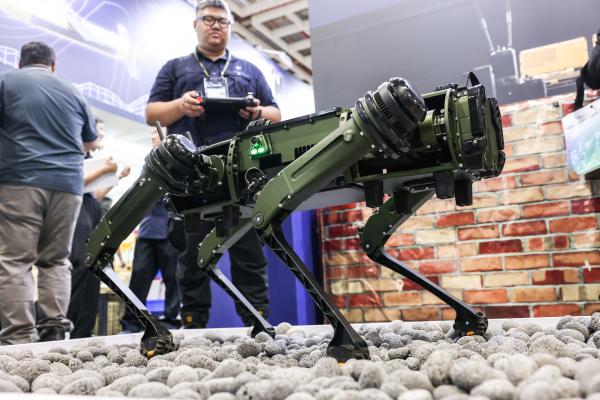
Join Hudson for a discussion with senior defense, industry, and policy leaders on how the US and Taiwan can advance collaborative models for codevelopment, coproduction, and supply chain integration.
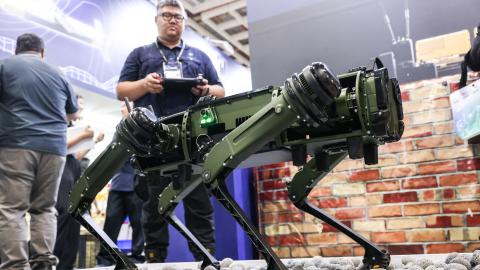
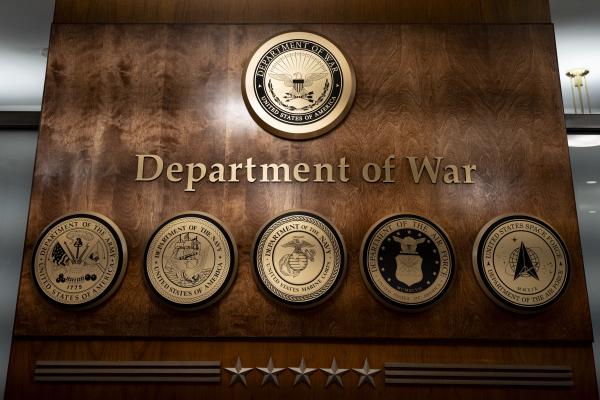
Join Senior Fellow Nadia Schadlow and an expert panel for a discussion on the DoW’s financial tools, the extent of the department’s authorities, and the role it will play in the broader American reindustrialization effort.
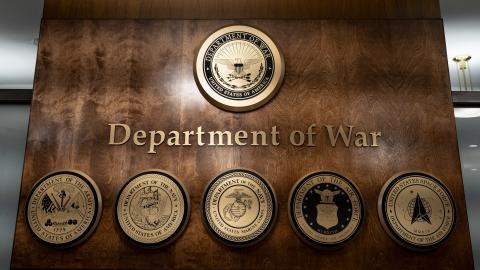
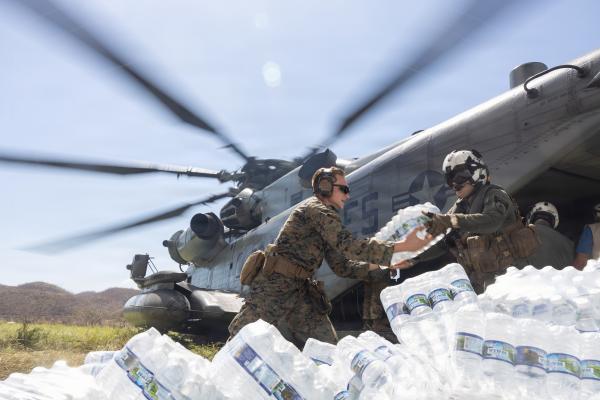
Moderated by Senior Fellow Matthew Boyse, a 35-year foreign service officer, this conversation will explore the evolving landscape of American diplomacy and development.
